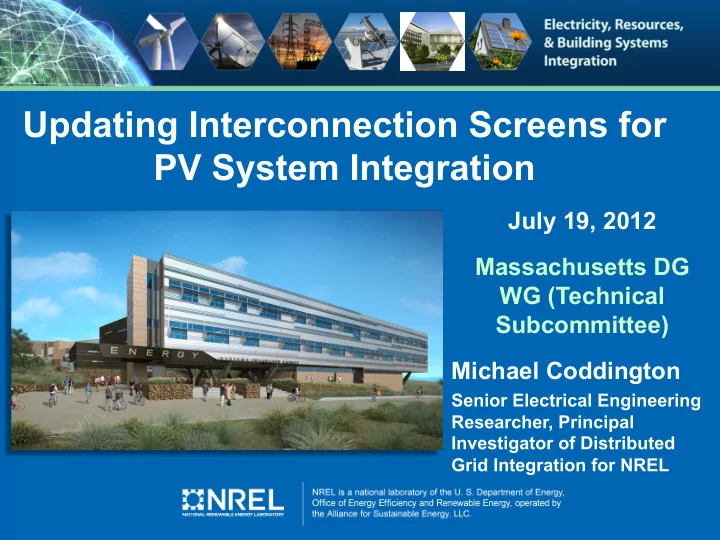

Updating Interconnection Screens for PV System Integration July 19, 2012 Massachusetts DG WG (Technical Subcommittee) Michael Coddington Senior Electrical Engineering Researcher, Principal Investigator of Distributed Grid Integration for NREL
Renewable and Efficiency Technology Integration PV Trends in the U.S. • Q3 2011 largest growth of PV installations in U.S. history with 449.2 MW – Utility installed solar over 200 MW • Q1-Q3 2011 over 1 GW of PV installed in U.S. • Total PV installed in U.S. over 3.1 GW, more than 10X 2005 levels • Utility solar installation up 325% from Q1-Q3 2011 Information from 2011 SEIA Report 2
Renewable and Efficiency Technology Integration Updating Screens for PV System Integration FERC ¡ Workshop ¡ ¡ July ¡17, ¡2012 ¡ 3
Renewable and Efficiency Technology Integration 4
Renewable and Efficiency Technology Integration Technical Report Goals • Increase PV deployment levels • Educate stakeholders • Validate the Critical Necessity to maintain Safety, Reliability, and Cost • Simplify and improve the interconnection process for utilities and stakeholders • Reduce approval time, costs • Lower interconnection costs supporting the DOE SunShot Initiative 5
Renewable and Efficiency Technology Integration Technical Considerations for PV System Location • Location of PV versus Substation • Size of conductor / Line impedance • Presence of voltage regulating devices • Combined generation on circuit • Exported power from PV system? • Presence and location of loads • Types of loads served by circuit 6
Renewable and Efficiency Technology Integration Why Focus on the 15% Screen? • Directly relates to the Level of Deployment of PV more than any other screen • Shows up in the majority of interconnection procedures in the U.S. • Perceived as a “bottleneck” to PV deployment • It is a limited metric derived early in interconnection development proceedings • Field experience challenges the rationale and significance of the 15% screen 7
Renewable and Efficiency Technology Integration Origin of the 15% Screening Criterion Quoting from CPUC Rule 21 Supplemental Review Guide: “The 15% line section peak load screen is meant as a catchall for a variety of potential problems that can occur as the level of penetration of generation within the distribution system increases” Problem: “One-Size Fits-All Approach” 8
Renewable and Efficiency Technology Integration Short-Term Solutions for Consideration 9
Renewable and Efficiency Technology Integration Potential Supplemental Screens for PV – Is the proposed DG a PV system? • Inverter-based, diurnal profile (peak 10-2) • PV behavior is different than traditional rotating generation (diurnal, low fault current, etc.) – Voltage Regulation Screen? – Anti-Islanding Screen? – Power Quality Screen? – Transmission Transient Stability Screen ? 10
Renewable and Efficiency Technology Integration Zones of Penetration Maps – Utility models determine locations that will allow greater levels of PV deployment based on impedance 11
Renewable and Efficiency Technology Integration Base penetration screen on minimum daytime load (MDL)data – Use actual data rather than a “rule of thumb” which uses half of 30% of peak load – Minimum load during 10 AM to 2 PM will capture the window of peak annual PV production (minimum daytime load) – 15% of peak load is a ROT to estimate 50% of minimum load. Consider using actual minimum daytime load data – SCADA systems can track MDL. Load allocation & estimation techniques can be applied 12
Renewable and Efficiency Technology Integration High PV Penetration Case Studies • Circuits can operate safely and reliably on different levels of penetration • Each feeder is unique and has different abilities to serve load and PV/DG • Some feeders may operate well at penetration levels over 70% (even over 100%!) • Other feeders will have major problems at penetration levels below 10%! • One-size-fits-all is not acceptable anymore 13
Renewable and Efficiency Technology Integration Advanced Technical Screens CPUC California Solar Initiative (CSI) Project (EPRI, NREL, SNL, Utilities) – Evaluate technical screens in CA and US – Classify feeders into topologies – Circuit monitoring and case studies – Modeling of high penetration/other circuits – Straw man screen development, iterations – Advanced technical screens based on feeder topology, system parameters, etc. should help reduce barriers to PV deployment 14
Renewable and Efficiency Technology Integration • Distribution Design Parameters (this might apply any time) – Larger conductors – Voltage Regulators – Better communications networks • Advanced inverter technology – Inverters can be “utility-friendly” • Low-Cost energy storage solutions • Grid Agent topology and control • Better communications and control • Greater deployment of “Smart Grid” technology 15
Renewable and Efficiency Technology Integration Thank you Michael.coddington@nrel.gov 16
Recommend
More recommend